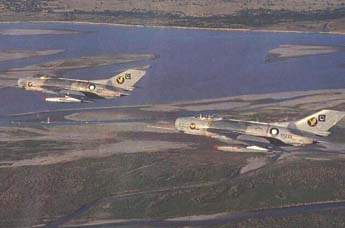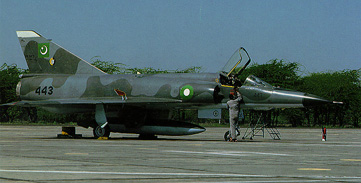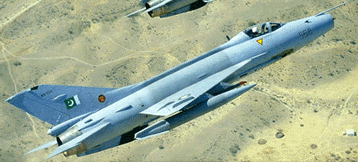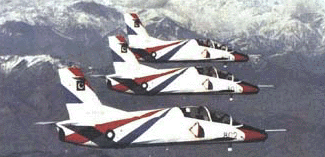


Pakistan Air Force (PAF) came into existence on 15th of August 1947, a day after
Pakistan gained its indepence from British India. Originally 56 aircraft were
transferred from Indian Air Force. This transfer comprised of Austers, Dakotas,
Harvards, Tempests and Tiger Moths. These aircraft were used to form three
squadrons and an AOP flight and a communications flight. Pakistan inherited
most of its structure from Royal Air Force. Most of its original officers were
RAF men on temperory attachments.
 The
first few years PAF also precured most of its equipment from Britain, which also
included its first jet fighters, the Supermarine Attackers arriving on August
1951. Soon afterwards Pakistan turned towards USA for Air Force hardware, in
return Pakistan joined USA against the spread of Soviet Communism. And for this
Pakistan expected to obtain a spectrum of aircraft from the USA. Expecting that
US would shower Pakistan with the similar amount of aid as Germany at the time,
Pakistan put forward a proposal for 44-squadron Air Force. Consisting of 10 day
fighter, five night fighter, five light-bomber, one photo recce, 12
fighter-bomber/figher recce, three transport and two maritime recce squadrons.
In return US was not as willing to supply such a huge quantity. US in return
visualized a smaller force consisting of six fighters, one night fighter and one
light bomber squadron. To make up these squadrons, US suplied 120 F-86F Sabres,
28 to 30 B-57s and about 12 F-104 Starfighters, for training T-33s and for
transport C-130s, HH-43s and HU-16s. Attritions were taken care of until 1963
under the same deal. At that time Pakistan-US relations took a downturn when
Pakistan formed two army divisions with US equipment supplied for reserve
stock.
The
first few years PAF also precured most of its equipment from Britain, which also
included its first jet fighters, the Supermarine Attackers arriving on August
1951. Soon afterwards Pakistan turned towards USA for Air Force hardware, in
return Pakistan joined USA against the spread of Soviet Communism. And for this
Pakistan expected to obtain a spectrum of aircraft from the USA. Expecting that
US would shower Pakistan with the similar amount of aid as Germany at the time,
Pakistan put forward a proposal for 44-squadron Air Force. Consisting of 10 day
fighter, five night fighter, five light-bomber, one photo recce, 12
fighter-bomber/figher recce, three transport and two maritime recce squadrons.
In return US was not as willing to supply such a huge quantity. US in return
visualized a smaller force consisting of six fighters, one night fighter and one
light bomber squadron. To make up these squadrons, US suplied 120 F-86F Sabres,
28 to 30 B-57s and about 12 F-104 Starfighters, for training T-33s and for
transport C-130s, HH-43s and HU-16s. Attritions were taken care of until 1963
under the same deal. At that time Pakistan-US relations took a downturn when
Pakistan formed two army divisions with US equipment supplied for reserve
stock.

In 1965 Pakistan was attacked by India. Though this wasn't a decisive war on the ground but in the air PAF proved its mettle by definitive victory over Indian Air Force. During the last days of the war Pakistani aircraft flew over Indian cities and airbases without any response from the opposing side. Pakistan was put under an arms embargo by the USA during the war. After the war Pakistan turned towards China and France to rebuild its war damaged air force. China supplied Shenyang F-6s (MiG-19s), which were both donated and purchased. From France Pakistan Purchased 24 Mirage IIIs. Also Pakistan aquired 90 F-86 Sabres through Iran after the war.
Pakistan and India once again went to war in 1971, after India directly
itervened in Pakistani civil war siding with Bengali seperatists. Though
Pakistan suffered losses on the eastern
 front,
but it kept India out of Western Pakistan. Even though India highly glorifies
this victory, it usually fails to tell the full story behind the victory. There
were only 90,000 Pakistan soldiers in Bengal when India invaded. Indian forces
were backed by almost 70 million civilians of Bengal. This proves how difficult
it could have been for Pakistan to hold Bengal with odds of 1 to 778 against
it. In any case Pakistan is much better off without Bengal anyway, and has now
developed diplomatic and economic ties with Bengladesh (formerly East Pakistan
or Bengal).
front,
but it kept India out of Western Pakistan. Even though India highly glorifies
this victory, it usually fails to tell the full story behind the victory. There
were only 90,000 Pakistan soldiers in Bengal when India invaded. Indian forces
were backed by almost 70 million civilians of Bengal. This proves how difficult
it could have been for Pakistan to hold Bengal with odds of 1 to 778 against
it. In any case Pakistan is much better off without Bengal anyway, and has now
developed diplomatic and economic ties with Bengladesh (formerly East Pakistan
or Bengal).
After the war Pakistan again turned towards China to ressuply its air
force. PAF ordered two
 batches of 60
F-6s to replace its F-86s, which were delivered between 1972 and 1977. Along
with F-6s - FT-5s were dilivered for advanced pilot training. FT-5s were two
seat versions of MiG-17s copied by China. Pakistan wasn't provided with FT-6s
(two seat F-6) until 1980. To accomadate overhauls China build an overhaul and
rebuilt factory at Kamra west of Islamabad. Also after the war Pakistan
recieved 28 or more Mirage 5s which were ordered before the war, plus the 10
Mirage III RPs ordered after the war. A dozen and a half other Mirages were
procured from Lebenon and France to build up numbers.
batches of 60
F-6s to replace its F-86s, which were delivered between 1972 and 1977. Along
with F-6s - FT-5s were dilivered for advanced pilot training. FT-5s were two
seat versions of MiG-17s copied by China. Pakistan wasn't provided with FT-6s
(two seat F-6) until 1980. To accomadate overhauls China build an overhaul and
rebuilt factory at Kamra west of Islamabad. Also after the war Pakistan
recieved 28 or more Mirage 5s which were ordered before the war, plus the 10
Mirage III RPs ordered after the war. A dozen and a half other Mirages were
procured from Lebenon and France to build up numbers.
No sooner the PAF had gotten over the 1971 war,
 the
situation in Afghanistan on Pakistan's west started getting worst. Soviet Union
invaded Afghanistan at the end of 1979. Pakistan didn't want to be the next
stepping stone for the USSR towards its strol to the Indian Ocean. So Pakistan
decided to support the local guerillas called Mujahideens (Holy warriors).
Mujahideens were supported logistically and technically in the field. For this
support of Mujahideen Pakistan was targetted several times by Afghani and Soviet
aircraft which delibrately crossed the international border to attack positions
with in Pakistan. When the United States saw Pakistan at the forefronts of
engaging the
the
situation in Afghanistan on Pakistan's west started getting worst. Soviet Union
invaded Afghanistan at the end of 1979. Pakistan didn't want to be the next
stepping stone for the USSR towards its strol to the Indian Ocean. So Pakistan
decided to support the local guerillas called Mujahideens (Holy warriors).
Mujahideens were supported logistically and technically in the field. For this
support of Mujahideen Pakistan was targetted several times by Afghani and Soviet
aircraft which delibrately crossed the international border to attack positions
with in Pakistan. When the United States saw Pakistan at the forefronts of
engaging the
 "Evil
Empire" Ronald Reagan decided to aid Pakistan in this struggle. The most
visible form of this aid were the first batch of F-16s. Which also turned out
to be the last. Pakistan also bought Chinese F-7s and A-5s during the same
period most likely with US aid. Pakistan used it's air force excecively during
the Afghan conflict, to patrol its border against Afghanistan and in the east
against India, which took full advantage of the situation on the western border
of Pakistan. Note: this is when India invaded Siachin Glacier. During this
period Pakistan engaged several Soviet aircraft.
"Evil
Empire" Ronald Reagan decided to aid Pakistan in this struggle. The most
visible form of this aid were the first batch of F-16s. Which also turned out
to be the last. Pakistan also bought Chinese F-7s and A-5s during the same
period most likely with US aid. Pakistan used it's air force excecively during
the Afghan conflict, to patrol its border against Afghanistan and in the east
against India, which took full advantage of the situation on the western border
of Pakistan. Note: this is when India invaded Siachin Glacier. During this
period Pakistan engaged several Soviet aircraft.
 PAF
also admits to shooting down eight intruders. Though the numbers could be much
higher, since several other bases were on full alert and aircraft from these
bases flew non stop combat air patrols (CAPs), for years. Also hundreds of
times aircraft from Peshawar airbase and Samungli airbase at Quetta were
scrambled to intercept intruding airplanes. PAF has never revieled any of the
records regarding these units. The most likely reason why PAF only chose to
make F-16s record public was the aid it was recieving from the USA and it wanted
to show that Pakistan needed those F-16s to protect its airspace. Pakistan got
through this difficult time with keeping vigilant eyes on its frontiers.
PAF
also admits to shooting down eight intruders. Though the numbers could be much
higher, since several other bases were on full alert and aircraft from these
bases flew non stop combat air patrols (CAPs), for years. Also hundreds of
times aircraft from Peshawar airbase and Samungli airbase at Quetta were
scrambled to intercept intruding airplanes. PAF has never revieled any of the
records regarding these units. The most likely reason why PAF only chose to
make F-16s record public was the aid it was recieving from the USA and it wanted
to show that Pakistan needed those F-16s to protect its airspace. Pakistan got
through this difficult time with keeping vigilant eyes on its frontiers.
After the Afghan conflict Pakistan once again concentrated on modernizing
its air force. PAF ordered 71 new F-16s and 100 plus F-7s to replace aging
F-6s.  Also
Pakistan bought 40 or so Mirage III Os from Australia to increase its Mirage
force which is the second largest now after France itself. Along with these
procurements Pakistan also entered into two developmental programs with China.
One of them the K-8 advanced jet trainer/ light attack aircraft has shown
magnificent results. The other project originally known as Super-7 ran into
several setbacks most noticeably the US sanctions against China after the
Tianamen Square massacre.
Also
Pakistan bought 40 or so Mirage III Os from Australia to increase its Mirage
force which is the second largest now after France itself. Along with these
procurements Pakistan also entered into two developmental programs with China.
One of them the K-8 advanced jet trainer/ light attack aircraft has shown
magnificent results. The other project originally known as Super-7 ran into
several setbacks most noticeably the US sanctions against China after the
Tianamen Square massacre.  Recently both China and Pakistan have signed Memorandum of Understading
regarding the Super-7 (now known as FC-1) project. To develop the project with
increased interest and energy. The first flight is due to take place in the
year 2001. Along with these developments Pakistan has also purchased 40 or so
Mirages to cover the advanced fighter gap.
Recently both China and Pakistan have signed Memorandum of Understading
regarding the Super-7 (now known as FC-1) project. To develop the project with
increased interest and energy. The first flight is due to take place in the
year 2001. Along with these developments Pakistan has also purchased 40 or so
Mirages to cover the advanced fighter gap.
Pakistan Air Force was given a title "saviors of the nation" during the
1965 War. PAF personal have since met all the difficulties to uphold that
title. PAF is nothing without its men, and PAF does more than most of the much
bigger Air Forces to train the richest pilots on the planet. PAF has a policy
of maintaining a minimum of two pilots per aircraft.
 But PAF
trains more pilots than that. Almost as many as the much bigger Indian Air
Force, which is atleast two and half times bigger in aircraft numerical
strength. PAF sends its pilots abroad mainly to Middle East as advisors, and
incase of conflict in the Middle East PAF pilots performed along with their
Arab allies. On several occasions PAF pilots emerged victorious in the air
battles between them and Israel. The pilots of PAF are still making history in
the Middle East. Just recently, United Arab Emirates cancelled it's order of 80
Block 60 F-16s just because US would not let UAE train Pakistani pilots on that
aircraft. This tells how much influence and prestige the PAF holds among the
Arab Air Forces. There is no doubt that Pakistani pilots fly Saudi Tornadoes
and F-15s and UAE's Mirage 2000s.
But PAF
trains more pilots than that. Almost as many as the much bigger Indian Air
Force, which is atleast two and half times bigger in aircraft numerical
strength. PAF sends its pilots abroad mainly to Middle East as advisors, and
incase of conflict in the Middle East PAF pilots performed along with their
Arab allies. On several occasions PAF pilots emerged victorious in the air
battles between them and Israel. The pilots of PAF are still making history in
the Middle East. Just recently, United Arab Emirates cancelled it's order of 80
Block 60 F-16s just because US would not let UAE train Pakistani pilots on that
aircraft. This tells how much influence and prestige the PAF holds among the
Arab Air Forces. There is no doubt that Pakistani pilots fly Saudi Tornadoes
and F-15s and UAE's Mirage 2000s.